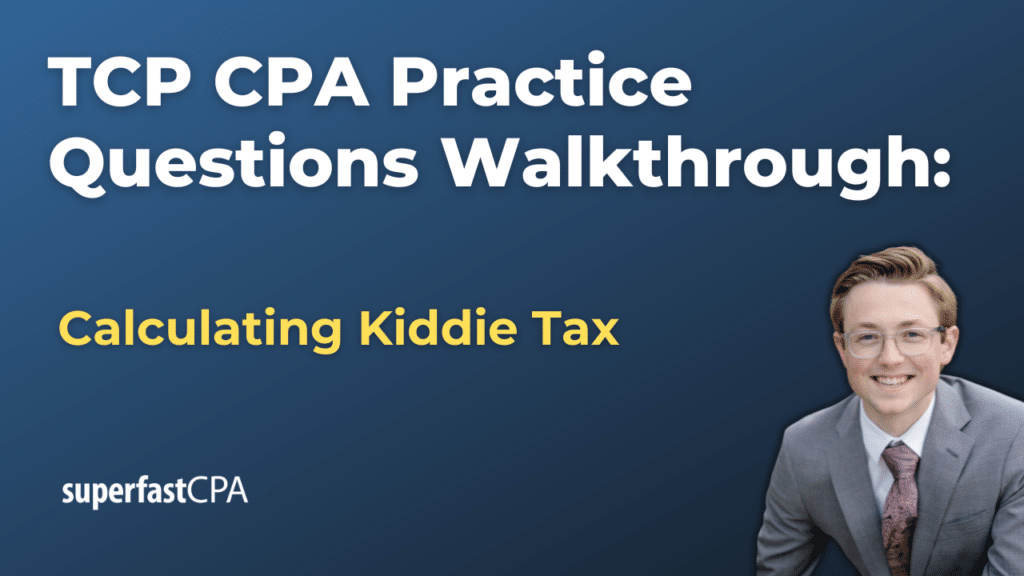In this video, we walk through 5 TCP practice questions about calculating the kiddie tax. These questions are from TCP content area 1 on the AICPA CPA exam blueprints: Tax Compliance and Planning for Individuals and Personal Financial Planning.
The best way to use this video is to pause each time we get to a new question in the video, and then make your own attempt at the question before watching us go through it.
Also be sure to watch one of our free webinars on the 6 “key ingredients” to an extremely effective & efficient CPA study process here…
Calculating the Kiddie Tax
Calculating the Kiddie Tax requires understanding its rules and how they apply differently depending on whether the child has only unearned income or both earned and unearned income.
What is the Kiddie Tax?
The Kiddie Tax is a U.S. tax rule that applies special tax rates to the unearned income of certain children to prevent parents from exploiting their child’s lower tax rate by shifting income to them. The Kiddie Tax subjects part of a child’s income to the tax rates that would apply to their parents, thus potentially increasing the tax due.
Who Qualifies Under the Kiddie Tax?
The Kiddie Tax applies to:
- Children under age 18 at the end of the tax year.
- Children aged 18 at the end of the tax year who did not have earned income that was more than half of their support.
- Children between ages 19 and 23 at the end of the tax year who are full-time students and did not have earned income that was more than half of their support.
Calculating the Kiddie Tax for Children with Only Unearned Income
- The child’s standard deduction for unearned income is a specific amount set for that year (something like $1,100 or $1,200).
- Unearned income above this deduction up to a certain threshold (e.g., $2,200) is taxed at the child’s tax rate.
- Unearned income exceeding this threshold is taxed at the parents’ marginal tax rate.
Example:
Suppose Emily, a 15-year-old dependent, received $5,000 in dividends. Her standard deduction is $1,100.
- Standard Deduction: $5,000 – $1,100 = $3,900 taxable income.
- Kiddie Tax Threshold: $5,000 – $2,200 = $2,800.
- Tax Calculation:
- $1,100 not taxed because it is below the standard deduction.
- $1,100 to $2,200 (or $1,100) at child’s tax rate.
- $2,800 at the parents’ marginal tax rate.
Calculating the Kiddie Tax for Children with Both Earned and Unearned Income
- The standard deduction is the child’s earned income plus a specific amount (such as $350 or $400), but not more than the usual standard deduction for an individual (for example, this was $12,550 in 2021).
- Taxable income is calculated by subtracting this deduction from their total income.
- Unearned income over a threshold is taxed at the parents’ tax rate.
Example:
Joshua, a 17-year-old dependent, earned $3,000 during a summer job and received $4,500 from dividends. His parents cover all his expenses.
- Standard Deduction: His earned income ($3,000) plus $350 = $3,350.
- Total Income: $3,000 + $4,500 = $7,500.
- Taxable Income: $7,500 – $3,350 = $4,150.
- Net Unearned Income: $4,500 – $2,200 = $2,300 (subject to parents’ rate).
- Tax Calculation:
- $2,300 of unearned income at the parents’ marginal tax rate.
- $1,850 of unearned income at Joshua’s rate ($4,150 taxable income – $2,300 taxed at parent’s rate).
Summary
Calculating the Kiddie Tax involves understanding the distinction between earned and unearned income, applying the correct standard deductions, and using the appropriate tax rates for different portions of income. Each scenario demands careful consideration of the child’s total income and the relevant thresholds to accurately determine the tax liability under the Kiddie Tax rules.












